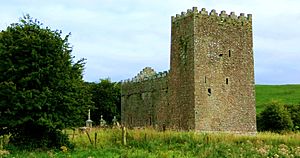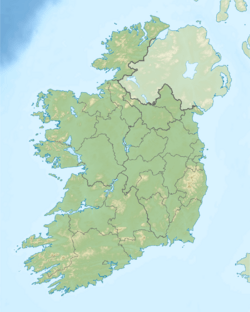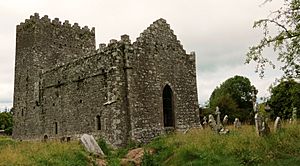Taghmon Church facts for kids
Quick facts for kids Taghmon Church |
|
|---|---|
| St. Munna's Church | |
|
Tigh Munna
|
|
 |
|
| 53°36′03″N 7°15′59″W / 53.600833°N 7.266389°W | |
| Location | Taghmon Glebe, Crookedwood, County Westmeath |
| Country | Ireland |
| Denomination | Church of Ireland |
| Previous denomination | Pre-Reformation Catholic |
| History | |
| Dedication | Fintán of Taghmon (Munnu) |
| Architecture | |
| Functional status | inactive |
| Years built | early 15th century |
| Specifications | |
| Number of floors | 4 |
| Materials | sandstone |
| Administration | |
| Diocese | Meath |
Taghmon Church (pronounced 'tack-mun') is a special kind of church called a fortified church. It is also a National Monument in County Westmeath, Ireland. This means it's a very important historical site.
Contents
Where is Taghmon Church Located?
Taghmon Church is found about 1.8 kilometers (just over a mile) east of Crookedwood. It is also southeast of a lake called Lough Derravaragh.
The Story of Taghmon Church
Early Beginnings: A Monastery
A long time ago, in the 6th or 7th century, a monastery was started here. It was founded by a saint named Fintán. He was also known as Munna or Munnu.
Building a Fortified Church
The church you see today, St. Munna's, was built in the early 1400s. It was designed as a fortified church. This means it was built strong, like a mini-castle, to protect people.
Times of Trouble and Change
In 1452, the church was attacked and robbed by Farrell Mageoghegan. After the Reformation, which was a big change in religion, the church became owned by the Nugent family. By 1622, it was almost completely ruined.
However, the church was used again by the Church of Ireland by 1755. It was repaired and made much better in 1843.
What Taghmon Church Looks Like
The church is a single building with a rounded, barrel-shaped roof inside. It has special walls on top called battlements. These battlements have unique "Irish crenellations" which look like teeth. There's also a machicolation above the door. This was a hole for dropping things on attackers.
The church and its tower also have a wide, sloping base. This is called a base-batter. It made the walls harder to climb.
The Tall Tower
The tall tower at the west end of the church was very important. It gave safety to the priests and other church members.
There is a carving called a sheela-na-gig above the first window on the north wall. These are old, mysterious carvings often found on Irish churches.
Inside the Tower
The tower has four levels. The first and third levels have rounded, vaulted ceilings. The second floor was where people lived. It had a fireplace to keep warm and window seats. There was also a "slop stone," which was a channel in the wall to get rid of waste water. Above this living area was a bedroom and a garderobe. A garderobe was an old-fashioned toilet.



